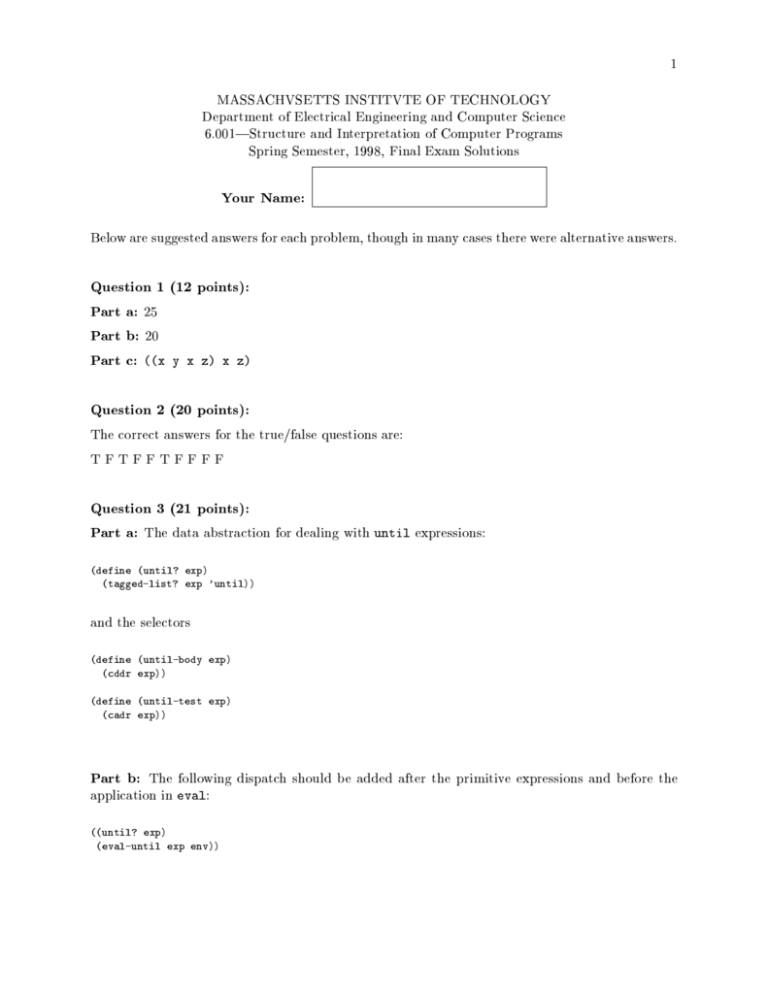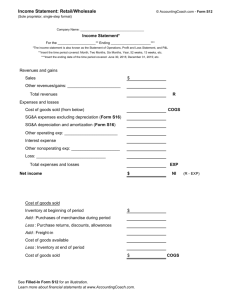Your Name: Question 1 12 points : Part a: 25 Part b: 20 Part c
advertisement

1 MASSACHVSETTS INSTITVTE OF TECHNOLOGY Department of Electrical Engineering and Computer Science 6.001|Structure and Interpretation of Computer Programs Spring Semester, 1998, Final Exam Solutions Your Name: Below are suggested answers for each problem, though in many cases there were alternative answers. Question 1 (12 points): Part a: 25 Part b: 20 Part c: ((x y x z) x z) Question 2 (20 points): The correct answers for the true/false questions are: TFTFFTFFFF Question 3 (21 points): Part a: The data abstraction for dealing with until expressions: (define (until? exp) (tagged-list? exp 'until)) and the selectors (define (until-body exp) (cddr exp)) (define (until-test exp) (cadr exp)) Part b: The following dispatch should be added after the primitive expressions and before the application in eval: ((until? exp) (eval-until exp env)) 6.001, Spring Semester, 1998, Final Exam Solutions|Your Name: Part c: The procedure eval-until: (define (eval-until exp env) (let ((return (eval-sequence (until-body exp) env))) (if (true? (eval (until-test exp) env)) return (eval-until exp env)))) Question 4 (14 points): The code to add the until special form of Question 3 to the Explicit-Control Evaluator: ev-until (save continue) (save exp) ; save the entire expression (assign unev (op until-test) (reg exp)) ; get the end test (save unev) ; save it for later (assign unev (op until-body) (reg exp)) ; get the body (assign continue (label ev-after-until-body)) ; where to go when done (save env) ; save the environment (save continue) (goto (label ev-sequence)) ; evaluate the body ev-after-until-body ; now need to evaluate the end test (restore env) (restore unev) (assign exp (reg unev)) (save val) (save env) (assign continue (label ev-after-until-test)) (goto (label eval-dispatch)) ; evaluate the end test ev-after-until-test ; check to see if end test is true (restore env) (test (op true?) (reg val)) (branch (label done-until)) ; branch if end test true (restore val) (restore exp) (restore continue) (goto (label ev-until)) done-until ; clean up when done (restore val) (restore exp) (restore continue) (goto (reg continue)) Question 5 (14 points): Part a: Argl will contain the value of: 2 6.001, Spring Semester, 1998, Final Exam Solutions|Your Name: (list 3) Part b: Lines 13 to 24 are created by compiling: (g y) Part c: After lines 25 to 27, plus lines 9 to 12, argl will contain: (list 9 3) Part d: After lines 25 to 29, plus lines 9 to 12, argl will contain: (list 27 9 3) Part e: Lines 6 to 39 are crated by compiling: (f x (g y) 3) Part f: A Scheme expression whose compilation would produce the entire code: (define (doit x y f g) (f x (g y) 3)) Question 6 (22 points): Part a: The environment diagram should have two frames, one from the application of the proce- dure and one from the internal let. Trial should point to a procedure object whose environment pointer points to the chain of frames starting with that created by the let. Part b: The denition of connect: (define (connect from to) ((from 'set-next) to) ((to 'set-previous) next)) The full denition of ripple: (define (ripple new current) ;; idea is to insert in right place by moving left or right (cond ((> (new 'value) (current 'value)) (cond ((null? (current 'next)) ;; nothing else (connect current new)) (else (ripple new (current 'next))))) ((null? (current 'previous)) (connect new current)) ((> (new 'value) ((current 'previous) 'value)) ; insert between (connect (current 'previous) new) (connect new current)) (else (ripple new (current 'previous))))) 3 6.001, Spring Semester, 1998, Final Exam Solutions|Your Name: Question 7 (12 points): Part a: (define factorials (cons-stream 1 (mul-streams factorials integers))) Part b: The denition of powers: (define (powers x) (define pwrs (cons-stream 1 (scale-stream pwrs x))) pwrs) Part c: (define (exp-terms x) (div-streams (powers x) factorials)) Part d: (define (exp-approx x) (define approx (cons-stream 0 (div-streams (powers x) factorials)))) Question 8 (10 points): Part a: A list of three pairs. Part b: A list of three pairs, where the car of the second pair points to the third. Part c: A list of three pairs, where the car of the rst points to the second, and the car of the second points to the third. Part d: Procedure would never return. A list of three pairs, where the car of the last points to the rst. Question 9 (23 points): Part a: Take the product of the even-valued leaves of the tree. (tree-manip test-tree 1 (lambda (x) (if (even? x) x 1)) car cdr *) 4 6.001, Spring Semester, 1998, Final Exam Solutions|Your Name: Part b: Flatten a tree. (tree-manip test-tree '() (lambda (x) (list x)) car cdr append) Part c: Deep-reverse a tree. (tree-manip test-tree '() (lambda (x) x) cdr car (lambda (x y) (append x (list y)))) Part d: Create a new tree, which keeps the odd-valued leaves of the original tree within the same tree structure, but completely removes even-valued leaves. (tree-manip test-tree '() (lambda (x) (if (odd? x) x '())) car cdr (lambda (x y) (if (null? x) y (cons x y)))) 5







